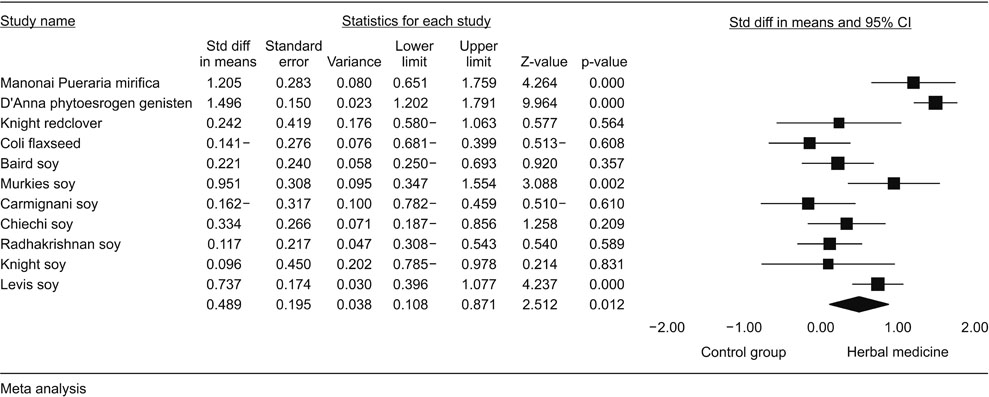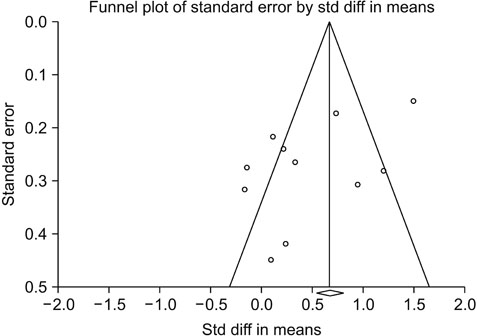J Menopausal Med.
2018 Apr;24(1):11-16. 10.6118/jmm.2018.24.1.11.
Effect of Herbal Medicine on Vaginal Epithelial Cells: A Systematic Review and Meta-analysis
- Affiliations
-
- 1Clinical Research Development Center, Imam Ali and Taleghani Hospital, Kermanshah University of Medical Sciences, Kermanshah, Iran. Zehneziba_64@yahoo.com
- 2Department of Medical Surgical Nursing, Kermanshah University of Medical Science, Imam Reza Hospital, Kermanshah, Iran.
- KMID: 2429215
- DOI: http://doi.org/10.6118/jmm.2018.24.1.11
Abstract
OBJECTIVES
The present meta-analysis aimed to assess the effect of the herbal medicine on the vaginal epithelial cells (VECs) among the menopausal subjects.
METHODS
The literature related to VECs exposed to various herbal medicines in menopausal women were searched on three databases, MEDLINE (1966-August 2017), Scopus (1990-August 2017) and Cochrane Library (Cochrane Central Register of Controlled Trials; 2014).
RESULTS
Totally, the meta-analysis was conducted on 11 randomised controlled trials. Based on the findings, the standardized mean difference (SMD) of maturation value (MV) was observed to be elevated by 0.48% (95% interval confidence [CI], 0.108-0.871; P = 0.012), as well as the heterogeneity was high (I2 = 84%; P < 0.001). The MV revealed a significant increase in soy group (SMD, 0.358; 95% CI, 0.073-0.871; P = 0.014) compared to the control group.
CONCLUSIONS
The herbal medicines exhibited a statistically significant effect on the VECs. A significant effect on the VECs was also found in the subgroup analysis of the patients, who received soy. However, further and extensive studies are required to achieve reliable outcomes.
Keyword
MeSH Terms
Figure
Reference
-
1. Abdi F, Mobedi H, Roozbeh N. Hops for menopausal vasomotor symptoms: Mechanisms of action. J Menopausal Med. 2016; 22:62–64.
Article2. Ghazanfarpour M, Kaviani M, Abdolahian S, Bonakchi H, Najmabadi Khadijeh M, Naghavi M, et al. The relationship between women's attitude towards menopause and menopausal symptoms among postmenopausal women. Gynecol Endocrinol. 2015; 31:860–865.
Article3. Golshiri P, Akbari M, Abdollahzadeh MR. Age at natural menopause and related factors in Isfahan, Iran. J Menopausal Med. 2016; 22:87–93.
Article4. Lee HH, Kim TH, Park J, Lee A, Park Y, Byun DW, et al. Expression of ezrin in vagina cells of postmenopausal rats after dietary administration of omega-3 Fatty Acid formula. J Menopausal Med. 2014; 20:97–103.
Article5. Direkvand-Moghadam A, Delpisheh A, Montazeri A, Sayehmiri K. Quality of life among Iranian infertile women in postmenopausal period: A cross-sectional study. J Menopausal Med. 2016; 22:108–113.
Article6. Levis S, Strickman-Stein N, Doerge DR, Krischer J. Design and baseline characteristics of the soy phytoestrogens as replacement estrogen (SPARE) study--a clinical trial of the effects of soy isoflavones in menopausal women. Contemp Clin Trials. 2010; 31:293–302.7. Kim HK, Kang SY, Chung YJ, Kim JH, Kim MR. The recent review of the genitourinary syndrome of menopause. J Menopausal Med. 2015; 21:65–71.
Article8. Kaari C, Haidar MA, Junior JM, Nunes MG, Quadros LG, Kemp C, et al. Randomized clinical trial comparing conjugated equine estrogens and isoflavones in postmenopausal women: a pilot study. Maturitas. 2006; 53:49–58.
Article9. Scarabin PY, Oger E, Plu-Bureau G. Differential association of oral and transdermal oestrogen-replacement therapy with venous thromboembolism risk. Lancet. 2003; 362:428–432.
Article10. Ghazanfarpour M, Sadeghi R, Roudsari RL. The application of soy isoflavones for subjective symptoms and objective signs of vaginal atrophy in menopause: A systematic review of randomised controlled trials. J Obstet Gynaecol. 2016; 36:160–171.
Article11. Moseley AM, Herbert RD, Sherrington C, Maher CG. Evidence for physiotherapy practice: a survey of the Physiotherapy Evidence Database (PEDro). Aust J Physiother. 2002; 48:43–49.
Article12. Borenstein M, Hedges LV, Higgins JPT, Rothstein HR. Comprehensive meta-analysis. Englewood, NJ: Biostat;2005.13. Baird DD, Umbach DM, Lansdell L, Hughes CL, Setchell KD, Weinberg CR, et al. Dietary intervention study to assess estrogenicity of dietary soy among postmenopausal women. J Clin Endocrinol Metab. 1995; 80:1685–1690.
Article14. Murkies AL, Lombard C, Strauss BJ, Wilcox G, Burger HG, Morton MS. Dietary flour supplementation decreases post-menopausal hot flushes: effect of soy and wheat. Maturitas. 1995; 21:189–195.
Article15. Carmignani LO, Pedro AO, Costa-Paiva LH, Pinto-Neto AM. The effect of dietary soy supplementation compared to estrogen and placebo on menopausal symptoms: a randomized controlled trial. Maturitas. 2010; 67:262–269.
Article16. Chiechi LM, Putignano G, Guerra V, Schiavelli MP, Cisternino AM, Carriero C. The effect of a soy rich diet on the vaginal epithelium in postmenopause: a randomized double blind trial. Maturitas. 2003; 45:241–246.
Article17. Radhakrishnan G, Rashmi NA, Vaid NB. Evaluation of isoflavone rich soy protein supplementation for postmenopausal therapy. Pak J Nutr. 2009; 8:1009–1017.18. Knight DC, Howes JB, Eden JA, Howes LG. Effects on menopausal symptoms and acceptability of isoflavone-containing soy powder dietary supplementation. Climacteric. 2001; 4:13–18.
Article19. Levis S, Strickman-Stein N, Ganjei-Azar P, Xu P, Doerge DR, Krischer J. Soy isoflavones in the prevention of menopausal bone loss and menopausal symptoms: a randomized, double-blind trial. Arch Intern Med. 2011; 171:1363–1369.20. Colli MC, Bracht A, Soares AA, de Oliveira AL, Bôer CG, de Souza CG, et al. Evaluation of the efficacy of flaxseed meal and flaxseed extract in reducing menopausal symptoms. J Med Food. 2012; 15:840–845.
Article21. Knight DC, Howes JB, Eden JA. The effect of Promensil, an isoflavone extract, on menopausal symptoms. Climacteric. 1999; 2:79–84.
Article22. Manonai J, Chittacharoen A, Theppisai U, Theppisai H. Effect of Pueraria mirifica on vaginal health. Menopause. 2007; 14:919–924.
Article23. D'Anna R, Cannata ML, Atteritano M, Cancellieri F, Corrado F, Baviera G, et al. Effects of the phytoestrogen genistein on hot flushes, endometrium, and vaginal epithelium in postmenopausal women: a 1-year randomized, double-blind, placebo-controlled study. Menopause. 2007; 14:648–655.24. Ghazanfarpour M, Latifnejad Roudsari R, Treglia G, Sadeghi R. Topical administration of isoflavones for treatment of vaginal symptoms in postmenopausal women: A systematic review of randomised controlled trials. J Obstet Gynaecol. 2015; 35:783–787.
Article25. Saghafi N, Ghazanfarpour M, Sadeghi R, Najarkolaei AH, Omid MG, Azad A, et al. Effects of phytoestrogens in alleviating the menopausal symptoms: A systematic review and meta-analysis. Iran J Pharm Res. 2017; 16:99–111.
- Full Text Links
- Actions
-
Cited
- CITED
-
- Close
- Share
- Similar articles
-
- An Introduction of the Systematic Review and Meta-Analysis
- The effect of isoflavone on vaginal dryness and dyspareunia in postmenopausal symptoms: a systematic review and meta-analysis
- Systematic Review and Meta-analysis in Digestive Cancer Research
- Effect of Vitamin D on the Vaginal Health of Menopausal Women: A Systematic Review
- Therapeutic Approaches to Atrophic Vaginitis in Postmenopausal Women: A Systematic Review with a Network Meta-analysis of Randomized Controlled Trials





